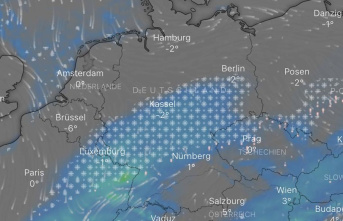A strong storm is approaching from the northwest. The wind whips up the waves on a Saturday in 1953. A gigantic waterfront rolls towards the southern Dutch coast. It is the harbinger of a catastrophe. 70 years ago, on the night of February 1st, the Netherlands and Great Britain were hit by the worst North Sea storm surge of the 20th century.
The hurricane and the spring tide that day are a dangerous combination. When the sun, moon and earth are aligned, the tides increase. This is the case with new and full moons. Then the difference between low and high tide is more extreme. About 2500 people die. In the Netherlands alone there are 1836, on the English coast more than 300. Many sailors lose their lives at sea.
Eyewitnesses in the Netherlands initially speak of an "insane natural spectacle". "We stood there and watched," recalls Sergeant Jan van de Velde. "The crazy thing was, people just went home afterwards, to bed." When the tidal wave reached the country at three o'clock in the morning, most people were asleep. Nobody warned her.
The flood affects the province of Zeeland in the southwest in particular. The dykes break under the force of the water, the water masses engulf fields and villages. "It was as if we were spectators at the end of the world," Boatswain Piet Saman later recalled. 80 percent of the dikes up to Rotterdam are destroyed or damaged that night. Many save themselves on roofs and trees. Hundreds are swept away by the floods, clinging to uprooted trees or broken houses.
Fishermen save people. But not all. Storm and water destroy power and phone lines. During the second tidal wave in the afternoon, the last houses and dykes collapse. Aid workers only reach the disaster area on the following Monday. An unprecedented international relief effort begins. A good 100,000 people are being evacuated, many of whom will never return.
To date, the disaster has left deep scars in the holiday region of Zeeland. February 1, 1953 makes it clear to many Dutch people: the water can swallow everyone. A good quarter of the country is below sea level. That makes the country vulnerable. A huge protection program is decided to be better prepared in case of a new tidal wave. The Delta Works are built - one of the world's largest defense bulwarks against the water - with five storm surge barriers, two locks and six dams. Construction began in 1954. It was not completed until 43 years later, in 1997.
The flood of the century was also an alarm signal for Great Britain. London, although hardly hit at the time, only narrowly escapes a catastrophe. Because the lower reaches of the Thames has an enormous tidal range of up to seven meters. In the worst case, a storm surge could force huge amounts of water from the North Sea into the river and flood large parts of the metropolis. As a consequence, an early warning system is also decided.
But construction only begins two decades after the 1974 disaster. The Thames Barrier near Woolwich in east London is finished a decade later. The nine pillars of the barrage rise out of the water with their gleaming silver structures like a gigantic hump of a whale. It stretches 520 meters across the Thames - making it one of the most impressive hydraulic structures in the world.
But at some point even this gigantic structure will no longer be sufficient to cushion the consequences of climate change with feared rising sea levels, more violent and more frequent storms and rainfall. The Environment Agency is working on a long-term plan to save London from sinking. There should be a new system by 2070.
The Dutch are also looking to the future. The government commissioner for water protection, Delta Commissioner Peter Glas, urges haste. "The climate is changing faster than we thought. We have much less time to prepare for it." Flood protection is an ongoing task. All dikes, totaling 3,500 kilometers in length, are currently being checked and strengthened so that they can withstand the predicted water levels by 2050. A mammoth task. But the Dutch have no choice. When the water comes, about 60 percent of the country will be threatened.











